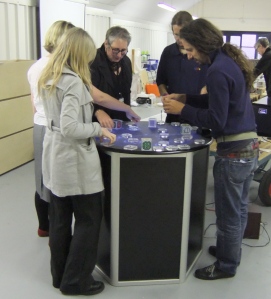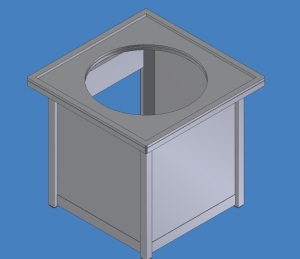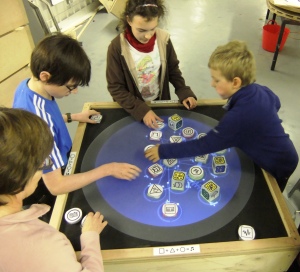As I mentioned in a previous post on its evaluation Reactable is the only exhibit for the Curiosity Zone that was bought in rather than made by us.
While our original plan was to buy in a few select exhibits that we loved from other places, over the course of the project we’ve geared more towards making our own. In part perhaps because it has given us a greater sense of control over the final product. This sense of complete control over every detail of the exhibit is reassuring, especially when the final products need to match so closely with the ethos of the Curiosity Zone.
So why was Reactable different? Because to us it immediately showed what the exhibition is all about; exploration, experimentation and of course, curiosity. It was because of these factors we were comfortable that despite not being part of it from the very beginning, it would still fit in well with all our other exhibits.
It also meant that we didn’t need to spend time on a ‘concept’ stage and because of this we were able to work on it alongside another exhibit, Sand.
Luckily the first hurdle, getting it here from Spain, was passed easily. A few days later Alex from the Reactable team arrived to teach us what it could do.
The hope was that after a bit of training we (and other users) would be able to produce something as beautiful as the composition below.
The Reactable you see above was already a functioning exhibit that worked well but there were still a few tweaks we needed to make it visually fit into the Curiosity Zone.
The first thing was to create some suitable housing.
The cube shape above gave clear interaction areas and also allowed for some space around the Reactable touch surface to store pucks that weren’t being used. The raised edge was also an important addition as it meant discs wouldn’t fall off the edge of the table and be continually damaged.
Our prototype housing was wooden and replicated the design above. For the surface we chose a dark material to highlight the interaction surface and provide a clear area for storing discs when not in use.
From this point forward very little of the Reactable housing changed apart from materials. The edging and legs became metal and the surface remained dark but became carpet to provide a soft, non-slippy, resting place for the discs.
There was also one ‘curious’ last minute addition.
We realised during the evaluation session of Reactable that people wanted to know how the device worked. We’re still debating what levels of explanation will be provided in the exhibition and in what form. But for now we thought an ideal compromise would be a chance to glimpse inside Reactable’s inner workings. And we felt the perfect shape for the window would be the universal sign of curiosity; the question mark.
The only major problem we’ve come across so far is an overheating of the projector inside after a few hours. We were aware that wood was a good insulator so just to be on the safe side we installed a fan and provided gaps around the top edge to allow warm air to escape.
In the workshop the exhibit ran continuously for hours without any problems. However it seems that there’s a big enough difference in the ambient temperature of the exhibition floor compared to that of our railway arch to have made a significant impact.
For now we can work around the problem and only have the exhibit on for certain amounts of time, and add more ventilation before its final install next year.
Now all of the above makes the physical modification of Reactable sound fairly straightforward. But this is only half of the story.
There’s more detail about what we discovered in a previous post but the main gist is that as brilliant as the Reactable was the interface was confusing at times for our advisors. They didn’t always understand what the discs were meant to represent. And our attempt to create a starting ‘equation’ on the side of the prototype unfortunately seemed to confuse matters more.
This is perhaps where buying an exhibit designed by others can raise some problems.
Because the Reactable software already had set parameters and blocks that did particular things the only thing we could change easily were the symbols that showed what each disc did. And of course choose which discs we provided for our users.
We decided that guidance was still needed but by something a little less forceful then a label on an exhibit. Often exhibits on labels can seem obligatory to visitors, they feel they’re not allowed to use the exhibit unless they read the label. Or they have to use the exhibit exactly as the label suggests.
With our first exhibit Rube I had created videos of small example chain reactions of objects to give people starting points. The idea being that they didn’t need to watch the film to begin but it might help them if they were stuck for a starting point.
When playing around with Reactable one afternoon I discovered that I could group the discs into three different categories; squares (sound generators), triangles (sound modifiers that can be linked to create chains) and circles (sound modifiers that don’t chain)
Once I started thinking of the discs in these simple terms I found creating music combinations much easier.
The main downside to this of course is that the discs are no longer individual on sight and there is nothing on the discs to hint at what it specifically does. The main question for us is whether this matters in the context of the exhibit.
In an attempt to answer this question for our floor evaluation we’ve created two sets of disc labels. Black and white ones, where the shapes are not individual in their own groups, or coloured, where each shape has a different colour. This would then mean that while the discs still don’t say what they do, you could remember that the ‘green square’ does one thing and the ‘orange triangle’ does another.
At the moment we feel that this is an acceptable compromise. What visitors do on the floor during the next week will tell us whether or not it works, or if we need to go back and take a step further.
However even if we decide to keep the simple designs as above, we’ve made sure that the other more complex features of Reactable will not go to waste.
The great thing about Reactable is that if you have the opportunity for prolonged exposure you are able to pick up those more complex functions. And from there the possibilities are endless.
Currently we feel that there is one group of people who will have that kind of opportunity and for who we will be providing the more advanced functions. Our Science Explainers.
For those visitors who wish to know more about the functions of the discs and explore further, our Science Explainers will have the ability to guide them and even show them extra special functions as well.
After all this there’s a part of me that thinks of Reactable like a long-lost member of the family. It didn’t start from us, and there were a few tweaks we had to do here and there, but it was always clear from the start that it belonged within the Curiosity Zone.
If you’d like to play with Reactable before May next year it’s now on the floor of the Centre and will likely be there until Monday of next week.
As always if you do have a play then please let us know what you think. Either on the blog, by tweeting scienceatlife or on our Facebook page (Science at Life). And we’d especially love to see any videos that you make of your creations!
Update: 8th December
We’ve discovered that despite our best efforts the projector can still only handle around an hour at a time. But rather than retest the exhibit at another time we’ve decided to implement specific exhibit testing slots.
Yesterday I drew up a quick sign to let all visitors know when the exhibit would be available.
Any signs we use are, like the exhibits, part of the evaluation process. At the moment we’re trying to find a balance behind clear information and slight humour to fit in with what we imagine the mood of Curiosity to be. I think signage is one of the most difficult things to get right in exhibitions so any experiences you’ve had (good and bad) will always be appreciated!










Hi, can you sell this thing? And how much it cost?
Hi Viatcheslav,
We bought the Reactable from Reactable Systems (http://www.reactable.com/about/). We bought a basic version which we then built our own housing for but you can buy different and more fully formed versions depending on what your needs are.
Hope that helps!